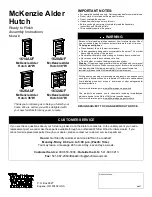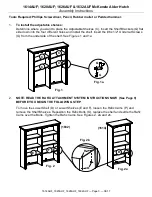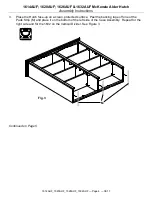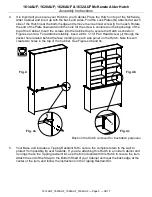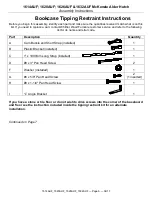
Whittier Finishing Hints
P.O. Box 2827
Eugene, OR 97402 USA
Toll Free: 800-653-3336
Ph: 541-687-0213
Fax: 541-687-2060
www.whittierwood.com
Page 2 of 2
Rev. 10/13
Preparing the surface
1.
Sand each piece with #220 grit sandpaper. Sand with
the grain of the wood on flat surfaces and opposite the
grain on turnings. Some parts may be plywood. Be
careful not to sand through the veneer. End grain such
as table top ends, seat edges and grooves on turnings
accept more stain. Extra sanding in these areas with
#320 grit sandpaper reduces stain absorption and
creates a more evenly stained piece.
2.
When sanding is completed, wipe the surface of your
furniture with a lint-free rag or tack cloth. Make sure the
item is free of dust before you proceed.
Staining
1.
Always read and follow all label directions
. Stir the
stain well before you start. Stir periodically throughout
the duration of the project to maintain uniform color
consistency.
2.
Test stain on an inconspicuous spot on your project.
Put at least one coat of your top coat over the test area
as it also affects the look of the stain.
Test every type
of wood that is in your kit. These are identified in the
Assembly Instructions.
Different types of wood may
react differently to the stain color. You might need to
add a second coat of stain to lighter woods to match
the darker woods in your kit.
3.
Apply stain with a poly brush or lint-free cloth. Apply
stain over a small area and wipe off excess. Working in
small areas will make the color easier to control.
4.
Cotton swabs are ideal for hard to reach areas.
5.
Allow the stain to dry thoroughly before you proceed.
Applying the top coat
1.
Always read and follow all label directions
. Stir your top
coat gently; do not shake. Shaking the can creates
bubbles that are hard to remove.
2.
All surfaces including the underside of table tops and
inside drawers must be sealed with at least one layer
of a top coat. This will help minimize wood swelling,
shrinkage, warping and cupping due to changes in
moisture content or temperature.
3.
Apply a minimum of two coats when you use
polyurethane or varnish (especially on all table top and
work surfaces). After allowing the first coat to dry,
sand lightly with #320 grit sandpaper. Remove dust
with a lint-free rag or tack cloth. For added protection,
apply additional coats. Lightly sand and wipe surface
with a lint-free rag or tack cloth between coats.
4.
Some finishes tend to slightly raise the grain. This can
be easily controlled with a light sanding between coats.
Do not use steel wool when you use water-based
finishes. Strands of steel fiber caught in the wood can
cause rust spots when coated with any water-based
product.
Painting
1.
Always read and follow all label directions.
Since there
is a large variation between paint manufacturers and
products, ask your paint supplier for specific advice on
how to best use the paint you purchase. Ask them
specifically for advice on finishing bare wood.
2.
First coat the wood with a primer. An oil based primer
works best for a smooth finish. If you do not wish to
use a solvent based primer, water based primer works
almost as well. However it may raise the wood grain
and require additional sanding.
3.
Buy quality brand paint in a satin, semi-gloss, or gloss
sheen. Apply a second coat for a smooth finish. Lightly
sand between coats using with #320 grit sandpaper so
that the second coat will bond well. Be sure to use a
tack cloth after sanding to remove any residue. Repeat
as desired.
4.
No top coat is required when using paint.

